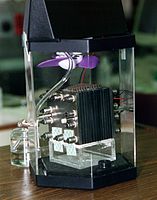
Photo from wikipedia
Abstract Development of an efficient, nonprecious, and durable oxygen reduction catalyst to replace high-cost Pt-based catalysts is one of the critical challenges in polymer electrolyte membrane fuel cells. In the… Click to show full abstract
Abstract Development of an efficient, nonprecious, and durable oxygen reduction catalyst to replace high-cost Pt-based catalysts is one of the critical challenges in polymer electrolyte membrane fuel cells. In the present study, we report a novel chemical method for the simultaneous doping of nitrogen and sulfur by in-situ polymerization of 6-N,N-dibutylamine-1,3,5-triazine-2,4-dithiol on a graphene framework. The composites are subjected to annealing at temperature between 900 °C and 1100 °C to form N-S/Gr catalysts. N-S/Gr-1000 catalyst exhibits an enhanced oxygen reduction reaction (ORR) activity dominated through 4e− pathway compared to other catalysts. The excellent durability of N-S/Gr-1000 catalyst with only a 20-mV negative shift in its half-wave potential after 10,000 repeated cycling contributes to the enhanced ORR. Although a larger shift in onset and half-wave potentials is observed for commercial Pt/C from the initial cycle, the linear sweep voltammogram recorded after 5000 cycles shows poor ORR kinetics with several redox steps. The potential of N-S/Gr-1000 catalyst as a cathode catalyst was validated in a membrane electrode assembly and in a real anion-exchange membrane fuel cell (AEMFC). A peak power density of ∼20 mW cm−2 was achieved under ambient temperature and pressure, which makes N-S/Gr-1000 a promising alternative nonprecious metal catalyst in AEMFCs.
Journal Title: Carbon
Year Published: 2017
Link to full text (if available)
Share on Social Media: Sign Up to like & get
recommendations!